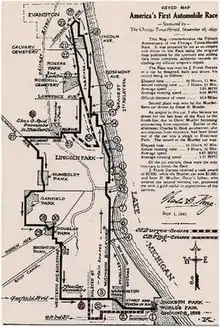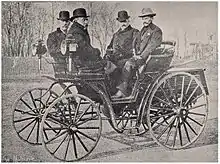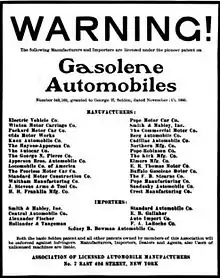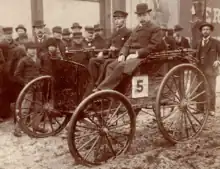Chicago Times-Herald race
The Chicago Times-Herald race was the first automobile race held in the United States.[1] Sponsored by the Chicago Times-Herald, the race was held in Chicago in 1895 among six motorized vehicles: four cars and two motorcycles. It was won by Frank Duryea's Motorized Wagon.[1] The race created considerable publicity for the motocycle, which had been introduced in the United States only two years earlier.


Race
On July 10, 1895, the Chicago Times-Herald announced a race to be held in the city, prizes totaling $5,000 (approximately $175,900 in 2022). The promotion was an attempt to foster growth of the young auto industry in the United States and to boost newspaper sales. The first automobiles in the nation were produced only two years earlier, and they were so new at the time that the paper's editors could not easily agree upon a name for them. After considerable wrangling, the editors decided to call it a Moto Cycle race, and first used the term in a July 15 article.[1]
The original course of the race was to run from Chicago north to Milwaukee, but the roads were found to be too poor for early cars to easily traverse. The route was changed to be only 54 miles (87 km) from Chicago to Evanston and back. The finish line was near what is now the Chicago Museum of Science and Industry (what had been the Palace of Fine Arts at the 1893 Columbian Exposition). The race was intended to be held on November 2, but few cars had shown up, and the race was rescheduled. Eighty-three cars were initially entered into the race, but only six arrived for the actual competition.[1][2] Many of the entrants did not have their cars completed on time, and several were unable to make the journey. Elwood Haynes' car, which was a favorite to win the race, was damaged en route and unable to compete.
Both Haynes and the driver of a Benz car were stopped by police while driving their cars into the city. They were forced to requisition horses to pull the cars because, as the police informed them, they had no right to drive their vehicles on the city streets. The situation caused the race to again be postponed while the Chicago Times-Herald editors convinced the city leaders to pass an ordinance to confirm the right of these vehicles to travel on city streets. Once the ordinance passed, the race was held on November 28, Thanksgiving Day. The day was snowy and 38 °F (4 °C), the roads muddy, with snow drifts in places.[1]
The first car to arrive at the starting line was a German-made car by inventor Karl Benz. In total, three Benz cars ran in the race. The only other four-wheeled car to run in the race was Frank Duryea's motorized wagon.[3] The two other vehicles that took part were two-wheeled automobiles. The "motorcycles" lacked the power to climb one of the course's grades. Another entrant was electric-powered, and its battery died because of the cold weather before getting very far. Just after starting, one Benz struck a horse, and was forced to leave the race. On the return trip from Evanston the Duryea began to take the lead.

Chicago Times-Herald Race Motocycle Contest in 1895
The Duryea car finished the race first, completing the race after 7 hours and 53 minutes of running time, 10 hours and 23 minutes total time, having traveled an average of 7 mph (11 km/h).[1][4] The Benz entered by Oscar B. Mueller crossed the finish line an hour and a half later. From point 31 of the course to the finish Mueller's car was driven by Charles Brady King because Mueller went unconscious from exposure.[5][6] King was originally an umpire to the race and of this motorcycle.[7] None of the other vehicles finished.[8]
The race was the first known automobile race in the United States.[2] Newspapers across the country carried stories about the race and many predicted the coming demise of horse-borne transportation, citing the cars' ability to travel even in poor weather. The success of the race sped up the rate of automobile development by at least five years in the United States due to the publicity of the event.[2] The commercial production of American automobiles began only a year later.[2]
The contest rules published prior to the race stated the following prizes were available.[9]
| Place | Prize Amount | Notes |
|---|---|---|
| First | $2,000 and a gold medal | Open to all competitors of the world. |
| Second | $1,500 | In the event the first prize goes to a vehicle of foreign manufacture, the most successful American entry will receive this prize. |
| Third | $1,000 | |
| Fourth | $500 | |
| Total | $5,000 |
Post-race prizes
The Fort Worth Gazette stated, "The prizes will be awarded on the showing made in the road race, and in the scientific tests which have been made under the supervision of the best experts in the country."[10] But it was not until December 5, 1895 that the official prize results were announced. The race judges determined that, "All contestants violated the rules of the race. None of the three contestants which finished at Jackson Park kept the course."[11]
"The judges were compelled to make their awards based on the showing in the tests and in the road race. The test took precedence in the rules, but the remarkable run made by Duryea and Mueller compelled substantial recognition. It was deemed fair to make an award of the gold medal based largely on tests, and it therefore, went to Morris-Salom. The other awards were made on road performances and on special points in design."[12] Total prize money awarded was $5,000.
| Vehicle Information | Prize Awarded | Prize Rationale and Notes |
|---|---|---|
| Duryea Motocycle Company Springfield, MA Duryea; Race #5 |
$2,000 | "Carriage made best performance and average speed. Best pull and compact design."[11] Failed to keep to the course, and was repaired by a blacksmith which violated the race rules.[12] |
| H. Mueller & Co. Decatur, IL Benz; Race #19 |
$1,500 | "Wagon made best performance in road. Most economy in operation."[11] Failed to keep to the course, and pushed by outsiders.[12] |
| R. H. Macy & Co. New York, NY Benz; Race #22 |
$500 | "Best showing made in road race."[11] Failed to keep to the course, and did not finish within the allowed time.[12] |
| Sturges Electro Motocycle Chicago, IL Sturges; Race #25 |
$500 | "For showing made in road race."[11] Abandoned after 12 miles (19 km).[13] The Sturges was built by William Morrison in Des Moines, Iowa between 1888 and 1890. This vehicle was purchased by Harold Sturges, and he demonstrated it at the World's Columbian Exposition held in Chicago during 1893.[14] |
| Morris & Salom Electrobat Philadelphia, PA Morris & Salom; Race #18 |
Gold medal (Valued at $250) |
"Best show in official tests."[11] Did not attempt to complete the course. Drove 15 miles (24 km) of race and then returned to testing headquarters.[15] Award of the gold medal was based on, "Safety; easy of control; absence of noise, vibration, heat or odor; cleanliness, and general excellence of design and workmanship."[16] |
| G. W. Lewis Motocycle Chicago, IL |
$200 | Special prize money given ". . . for friction driving device and brake and a reduction gear for increasing speed."[12] |
| Hayes & Apperson Gasoline Wagon Kokomo, IN |
$150 | Special prize money given ". . . for plan of preventing vibration by balance of driving engines."[12] |
| George Hertel Gasoline Wagon Chicago, IL |
$100 | Special prize money given ". . . for a device for starting the motor from the operator's seat in the vehicle."[12] |
| De La Vergne Refrigerating Machine Co. New York, NY Benz; Race #7 |
$50 | Special prize money given ". . . for counterbalance of engine."[12] Some papers state they quit the race at 16th Street and others at 64th Street.[13][17] |
Epilogue



The Smithsonian Institution states the following regarding the winning Duryea car. "This car was unfortunately destroyed through a workman's misunderstanding many years ago."[18] The second-place car of Hieronymus Mueller is on display in the Mueller Museum in Decatur, Illinois.[19]
In addition to the enormous amount of publicity the race generated, several other automotive developments were related to this race.
- Motocycle. The early term for the automobile, "motocycle", was born out of a pre-race contest sponsored by the Chicago Times-Herald newspaper to replace the term "horseless carriage" with something better.[20] The term was never very popular, and it has largely fallen into disuse. The Indian Motocycle Manufacturing Company used this term consistently to describe its motorcycles from their earliest days until 1953.
- First automotive club. Charles King, one of the drivers that was to have taken part in the November 2, 1895, contest, sent out letters on October 8, 1895, proposing an automobile club be formed. This led to the creation of the American Motor League on November 1, 1895, in Chicago on the eve of what became the exhibition run between Mueller and Duryea motocycles. Charles Duryea was elected president on November 29, 1895, at the second meeting.[20]: 31–32
- First U.S. automotive trade publication. Edward E. Goff in Chicago, almost certainly inspired by the Chicago Times-Herald Race, began publishing the first English language automobile magazine Motocycle in October 1895. This was one month prior to the well known publication Horseless Age which claimed to be the first such publication.[20]: 31
- Selden patent. The Morris & Salom Electrobat was the beginnings of the Electric Vehicle Company of Philadelphia.[20] This firm, although no longer producing automobiles by 1899, acquired the legal rights to the Selden patent, and began the process of trying to collect licensing fees from all U.S. automobile manufacturers.[20]: 116–117 [21]
See also
References
- "Chicago Times-Herald Race of 1895". Encyclopedia of Chicago. Retrieved May 8, 2009.
- Flink, James A. (1998). The Automobile Age. Cambridge, Massachusetts: MIT Press. p. 23. ISBN 0-262-56055-0.
- May, George W (1996). Charles E. Duryea Automaker. Chillicothe, Illinois: River Beach Publishing. p. 90.
- Rubenstein, James M. (2014). A Profile of the Automobile and Motor Vehicle Industry. New York, New York: Business Expert Press. p. Chapter 2. ISBN 978-1-60649-536-0.
- King, Charles B. (1945). A Golden Anniversary 1895–1945 / Personal Side Lights of America's First Automobile Race. New York, New York: Super Power Printing Company. pp. 32–37.
- May, George S. (1975). A Most Unique Machine. Grand Rapids, Michigan: William B. Eerdmans Publishing Company. p. 30. ISBN 0-8028-7032-5.
- "The Start Of The Motocycle Race, Jackson Park and the Midway Plaisance". The Chicago Times-Herald. Chicago, Illinois: Chicago Times-Herald. November 29, 1895. p. 1.
- Madden, W. C. (2003). Haynes-Apperson and America's First Practical Automobile: A History. Jefferson, North Carolina: McFarland & Company, Inc. pp. 11–13. ISBN 0-7864-1397-2.
- "Times-Herald Contest". The Horseless Age. Vol. 1, no. 1. New York, New York: E. P. Ingersoll. November 1895. p. 53.
- "Duryea, Wins the Great Motocyle Contest". Fort Worth Gazette. Fort Worth, Texas. November 29, 1895. p. 2.
- "Prizes For Motcycles Awarded". Chicago Tribune. Chicago, Illinois. December 6, 1895.
- "Motocycle Road Race". Decatur Daily Review. Decatur, IL. December 7, 1895. p. 1.
- "Motocycles Race". St. Paul Daily Globe. St. Paul, MN. November 29, 1895. p. 1.
- Harter, Jim. Early Automobiles: A History in Advertising Line Art, 1890–1930. Texas: Wings Press. ISBN 9781609404895.
- "The Duryea Machine Won". The Evening Herald. Shenandoah, PA. November 29, 1895. p. 2.
- "Awards In The Motocycle Race". Sterling Evening Gazette. Sterling, IL. December 6, 1895. p. 7.
- "Race of Motocycles". The San Francisco Call. San Francisco, CA. November 29, 1895. p. 4.
- "Smithsonian Automobile Collection, An American Industry is Born". Smithsonian Institution. Smithsonian National Museum of American History. Retrieved November 10, 2017.
- "Biography of Hieronymus Mueller". Mueller Museum. Retrieved November 10, 2017.
The original Mueller-Benz car can be found in the Mueller Museum.
- May, George S. (1975). A Most Unique Machine. Grand Rapids, Michigan: William B. Eerdmans Publishing Company. p. 26. ISBN 0-8028-7032-5.
- May, George W (1996). Charles E. Duryea Automaker. Chillicothe, Illinois: River Beach Publishing. pp. 116–117.
External links
- "Chicago Times-Herald Race of 1895". Encyclopedia of Chicago. Retrieved May 8, 2009.
- "Times-Herald Race". North American Motorsports. Retrieved May 8, 2009.
